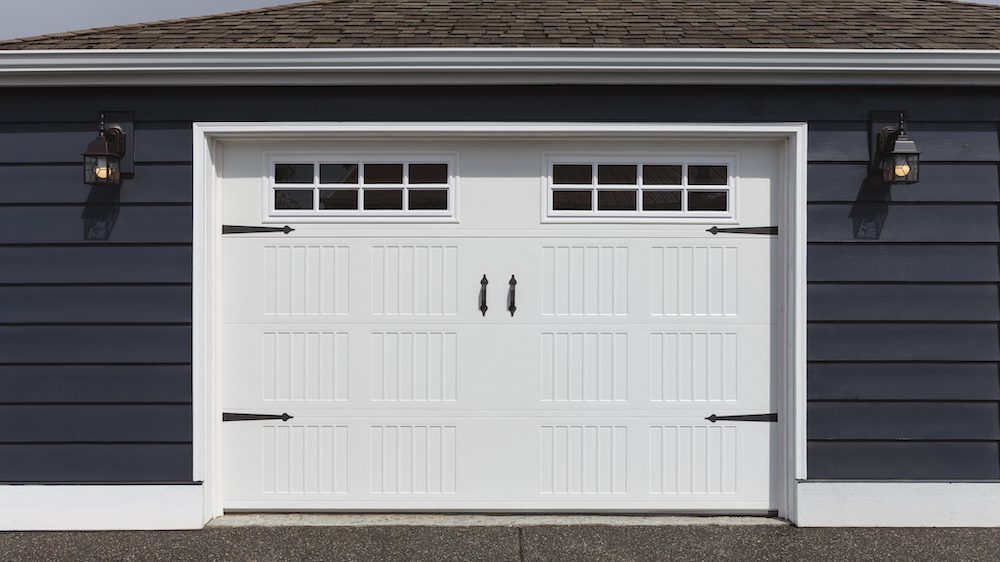
Getty Images
Most people don’t pay much attention to their garage door, as long as it’s working. But the garage door is the face of a house. When considering improving your home’s exterior appearance, updating your bland-looking garage door can be a good investment.
“Your garage door is likely the most frequently used entrance to your home and makes up a large portion of your home’s exterior appearance, so replacing it can increase your home’s curb appeal and value,” says Michelle Nichols, an expert in garage doors and openers at The Home Depot.
The top three reasons why people replace their garage door are not liking the look of their existing door, needing to replace a broken door, and wanting to add an automatic door opener, says David Steckel, a home expert at Thumbtack. If you fall into one of these camps, here are a few things you should know before replacing your garage door.
1. Replacing a garage door can pay off
Replacing your garage door has a return on investment of nearly 94% and can help improve your home’s resale value, according to Remodeling magazine.
Plus, a functional garage door can help you save money.
“Older doors with poor seals and deteriorating insulation could lead to your HVAC system working harder and your energy bills increasing,” says Nichols.
So how often should you replace your garage door? With proper maintenance, a garage door should last about 10 to 20 years.
2. The cost to replace a garage door varies
The average cost to replace your garage door is $3,900, according to Remodeling magazine. However, the true cost “depends on the size and material of the door,” says Bailey Carson, home care expert at Angi, the home remodeling recommendation site formerly known as Angie’s List.
For example, the cost for a 16-by-7-foot garage door can range from $750 to $4,000, with wood doors ranging from $1,200 to $4,000, and aluminum from $1,500 to $2,000.
“To make sure you’re getting a fair price from a high-quality professional, take the time to do thorough research and get estimates from at least three local pros,” says Carson. She says to make sure to check their ratings and reviews online, and ask for references and photos of recently completed projects.
3. Garage doors come in a variety of materials
“Garage doors have come a long way and have become a major component of a home’s exterior. From aluminum to wood, with glass openings or intricate panel designs, there are dozens of options for you to choose from,” says Steckel.
The four most common materials for garage doors are aluminum, steel, wood, and composite wood, and each has its pros and cons.
Carson says aluminum is rust-resistant and a great option for homeowners in more humid climates, while steel is very versatile, with lots of options regarding color, insulation, and price.
Wood garage doors are flexible and molded for specific or unique designs.
“However, depending on your climate, these doors can require more maintenance to prevent rotting, shrinking, and cracking,” says Carson.
Composite wood can be great material for garage doors since it is moisture-resistant, is insulated, and can be painted or stained.
“In addition to the material, think about the style of door you would like. There are a lot of options here, such as single tilt-up, single roll-up, custom roll-up, and solid-wood custom models. It’s great to talk to a pro about what option fits your budget, garage size, and priorities around noise and space,” says Carson.
4. The material you choose should fit your climate
“Your climate will impact whether you’ll want an insulated door, especially if it’s attached to your home, or if you plan to use the garage for more than just parking cars. An insulated door can also improve energy efficiency for your home, lowering your monthly bills,” says Carson.
Certain states now require specific levels of wind-load reinforcement, so it’s important to check your local codes to make sure you’re in compliance.
“If you live in an area that often reaches hurricane-force winds, it’s important that your new garage door meets wind load reinforcement requirements to prevent any accidents down the line,” says Steckel.
For example, Florida requires garage doors to withstand 150 mph winds in order to keep everyone safe during major storms, Carson says, “so it’s important to check all local codes and secure any required permits before starting the installation.”
5. Don’t forget the garage door opener
In addition to maintaining the garage door itself, it’s important to keep the garage door opener in tiptop shape.
Nichols recommends performing maintenance checks on the garage door tracks at least twice a year and to pay attention to springs, cables, rollers, and pulleys to check for damage, to inspect any breakdown of garage door materials, and to ensure that the door is lubricated regularly and clear any debris.
Look for rust, deterioration, or broken strands on the lift cables. If they look worn, call for service, says Nichols.
If you’re in the market to replace your garage door opener, Steckel recommends going for modern conveniences.
“When selecting an opener, I would consider adding a Bluetooth option to the device and get one that has a light included as well,” she says.
The post 5 Facts Homeowners Need To Know About Replacing Their Garage Door appeared first on Real Estate News & Insights | realtor.com®.
No comments:
Post a Comment